|
The Story of Tennis
in three-parts |
Part
1 The Tennis Racket
1. French monks of the 13th century
played a version of modern-day tennis in the confines of their
monestary courtyard. They whacked the ball with an open hand,
thereby calling it jeu de paune, or "Game of the
Palm."
2. The clerics spent so much time playing the game that the
Archbishop of Rouen banned it in A.D. 1245.
3. The tennis racket evolved slowly. At first players wore bloves.
Then they wound leather cords around the fingers.
4. For a while they used a paddle until someone wrapped parchent
around a frame. Unfortunately....
5. Manuscripts began disappearing from libraries and showing
up on tennis rackets.
6. Around A.D. 1500 the players bagan to run strands of sheep
gut diagonally across the frame.
7. The game spread across the English Channel where the British
started calling it TENNIS, an English spin-of of the term TENEZ, meaning
"hold" or "take" which the server yelled
when he was about to hit the ball to his opponent.
8. William Shakespeare mentioned tennis in his play Henry
V. King Henry V ruled Great Britain 1413 - 1422, and was
an avid player.
9. King Henry VIII loved the game so much that heinstalled a
tennis court at Hampton Court Palace in the late 1520s which
is still there today. |

Part
2 The Opening Serve
1. Mary Ewing Outerbridge
has the distinction of introducing tennis tothe United States
in 1874
She had played the game while on vacation in Bermuda that
previous January and returned home to Staten Island, New
York with rackets, balls, and nets.
2. Mary's brother Emilio set up a tennis court at the Staten
Island Cricket and Baseball Club. That site is now a parking
lot for the Staten Island Ferry.
Regarded as the Mother of Tennis, Mary died in 1886 at
the age of 34.
3. An avid sportsman, President Theodore Roosevelt had
a tennis court built on the south side of the west wing of the
White House around 1902.
Teddy had a unique way to hold his racket. |
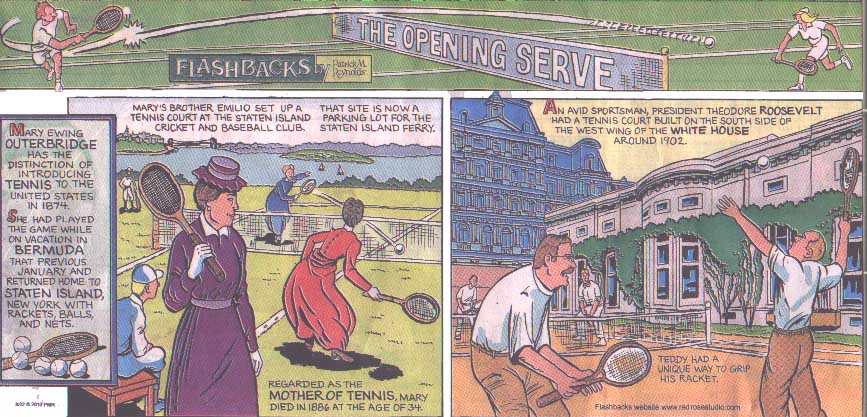
Part
3 The Tennis Cabinet
1. (left side) President Theodore
Roosevelt installed the first tennis court at the White House.
Playing alongside Roosevelt were officials high and low, eager
undersecretaries, and foreign diplomats.
Teddy's tennis buddies were called The Tennis Cabinet.
There were more than 30 players during his administration including:
Henry Stimson, U.S. Attorney for southern New York; later
he was the Secretary of State under President Herbert Hoover,
and Secretary of War during World War II.
2. (in circle) The president often invited celebrities to play,
such as...
William "Pudge" Heffelfinger, a noted stockbroker
who, as a Yale guard, made the first All-American football roster
and, in 1892, was the first to get paid to play football.
One of Theodore's favorite sporting diplomats was the french
ambassador Jules Jusserand.
The son of a former predident, James R. Garfield was a
Civil Service commissioner and later TR's Secretary of the Interior.
Garfield was the last survivor of Theodore Roosevelt's administration
when he died in 1950.
3. (right side) A staunch conservationist, Gifford Pinchot
headed the U.S. Bureau of Forestry for Presidents McKinley and
Theodore Roosevelt. He went on to serve as the governor of Pennsylvania
twice, 1923-26 and 1931-34. |
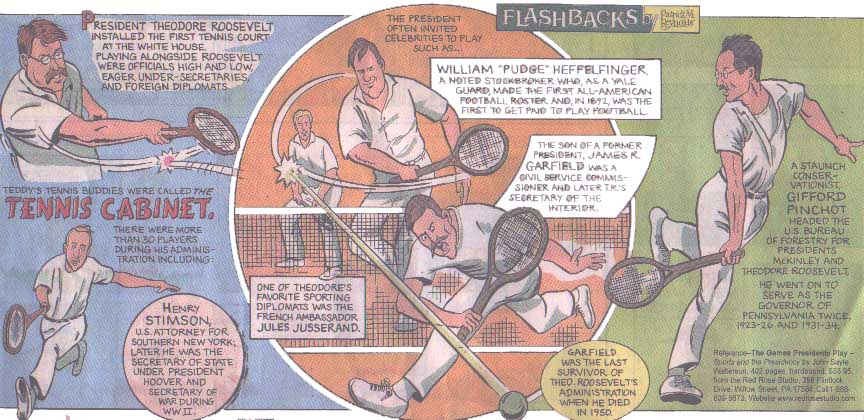
For into about tennis at the White
House, we recommend...
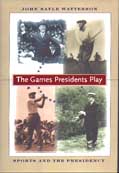 |
The
Games Presidents Play Sports and the Presidency by James Sayle Watterson
Looking at the athletic strengths, feats, and shortcomings of
our presidents, John Watterson explores not only their health,
physical attributes, pesonalities, and sports IQ., but also the
increasing trend of Americans in the past century to equate sporting
achievements with courage, manliness, and political competence.
Find out how good horsemanship played a critical role in getting
elected to high office.
6" x 9" 402 pages, index, illustrated, hardbound
#497 Games Presidents Play $29.95  |
|
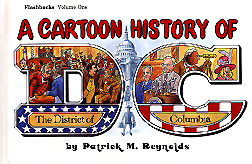 |
Flashbacks Volume One
A Cartoon of the
District of Columbia
Patrick M.
Reynolds brings history
to life with a sense of humor. His exciting drawings put you
on the scene with the conflicts, madness, plus the wheeling and
dealing that resulted in the location and construction of the
U.S. capital city, despite
all the bickering, petty jealousies, and down-right stupidity. This volume is almost out of print, hence the higher price.
11¾" x 7½" 106 pages, full color illustrations,
index, paperbound
ISBN 0-932514-31-6
#F1 Cartoon History of DC $25.00  |
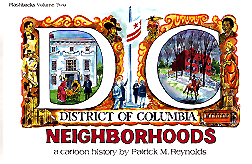 |
Flashbacks Volume Two
DC Neighborhoods Flashbacks Vol. Two
Artist-writer Patrick
M. Reynolds takes you to the Washington that tourists seldom
see The U.S. capital expanded with the growth of public transportation
into such areas as Shepard Park, Takoma Park, Chevy Chase, Kalorama,
Dupont Circle, Adams Morgan, Capital Hill, LeDroit Park, Tenleytown,
Brookland, and others. Stories in this book go back to the explorations
of Capt. John Smith in the 1600s and the Indian Wars of early
Virginia, continuing into the 20th century with the introduction
of the cherry trees to Washington and the end of segregation
in public schools.
11¾" x 7½" 106 pages, full color illustrations,
index, paperbound ISBN 0-932514-33-2
#F2 Cartoon History of DC $14.95  |
|



